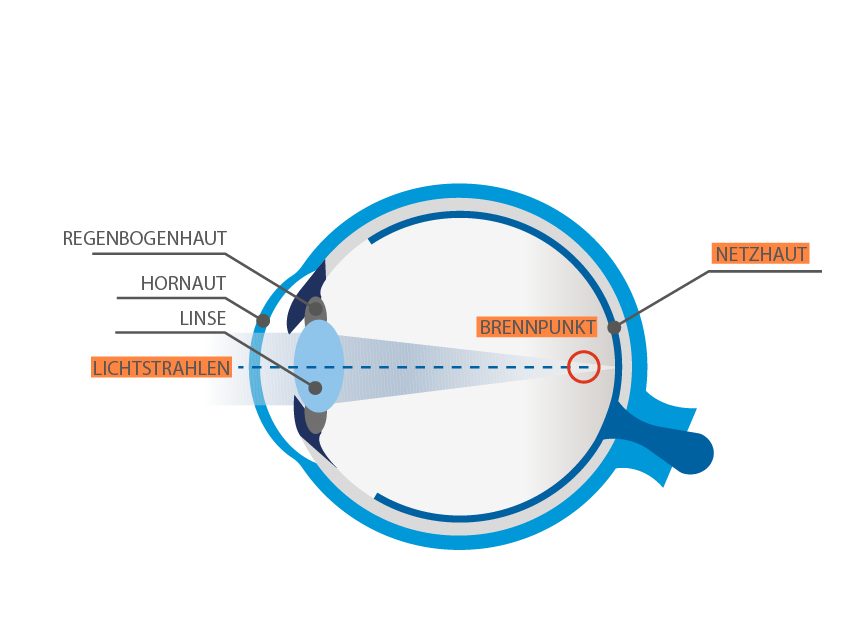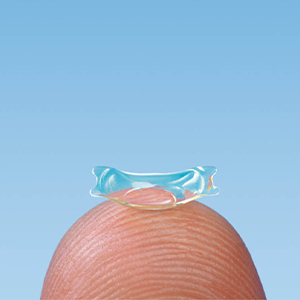How does myopia occur?
In short-sighted people, the eyeball is too long or the refractive power of the lens is too strong in relation to this length. As a result, incoming light rays are focused in front of the retina instead of on it. While the eye can compensate well for this in the close-up range, blurring occurs when seeing in the far range.
In addition to genetic components, constant close-up vision, such as reading on a smartphone or working on a computer, can also affect the length of the eye. Sufficient exercise outdoors is particularly important in childhood due to the associated relaxation of the eyes. In addition, daylight also has an inhibiting effect on excessive eye growth.
How common is myopia?
Myopia is the most common form of ametropia worldwide. In Germany alone, around 25% of all people are affected by myopia. About 1.5 billion people worldwide are nearsighted. In heavily industrialized countries there are particularly many short-sighted people, which is why short-sightedness is also referred to as a disease of civilization.


What are the symptoms of nearsightedness (myopia)?
In the case of short-sightedness, the affected person perceives his immediate surroundings sharply (“short-sighted”), while objects that are further away can only be seen blurred.
Possible symptoms of myopia are:
- blurred vision in the distance
- Frequent squinting of the eyes
- deteriorated night vision
- Headaches
- Tired eyes
Diagnosis of myopia
If myopia is suspected, a comprehensive medical examination of the eyes should be carried out. In this way, the type and severity of the ametropia can be determined at one appointment. But be careful: the eyesight depends to a certain extent on the shape of the day, which is why it is advisable to take multiple measurements at different times of the day for the initial diagnosis, depending on the severity of the ametropia.
Myopia is measured with diopters in the minus range. CARE Vision usually carries our eye laser treatment for myopia of up to -10 diopters.
Eye laser treatments for myopia
Short-sightedness can usually be compensated very well by eye laser treatment. Fogged glasses, irritated eyes from contact lenses and cumbersome cleaning procedures will then be a thing of the past.
Most patients can use LASIK, FEMTO-Lasik, PRK/Lasek or the Trans-PRK method to correct myopia. All treatments are performed on an outpatient basis and are painless. The use of the laser itself only takes a few seconds. After a detailed examination of your eyes, your attending specialist will determine the most suitable correction method for optimal treatment results. Of course, your personal circumstances and habits will also be taken into consideration.

Myopia surgery doesn’t work doesn’t work – what now?
In the case of particularly severe short-sightedness (over -10 diopters), eye laser treatment is usually no longer the optimal correction method. In this case, an ICL lens treatment often enables the patient to start a life without glasses.
Even if the cornea is very thin or presbyopia is already starting, lens treatment, for example with multifocal lenses (MIOL treatment), is preferable to laser eye surgery in some cases.

Myopia and other ametropia
Yes, short-sightedness and astigmatism can be corrected in one treatment step, provided you are eligible for laser eye surgery. Many patients have a combination of these two.
Yes, nearsightedness and farsightedness can be corrected very well in most cases with an eye laser correction.
Questions about myopia & laser treatment for myopia (FAQ)
Short-sighted people can suffer from other ametropia at the same time. For example, astigmatism can also be present and presbyopia can develop from around the age of 40.
A myopia of up to about -10 diopters can usually be corrected with an eye laser treatment. If the patient suffers from an even greater ametropia, a lens treatment with intraocular lenses/phakic lenses can make the step into life without glasses possible. At CARE Vision, after a comprehensive examination of the eyes, an experienced ophthalmologist decides on the most suitable treatment method for the patient.
Myopia is partly hereditary. However, personal factors also have an influence on the occurrence and course of myopia.
There is no maximum age for the correction of myopia. After a comprehensive examination of the eyes and taking into account the age of the patient, the experienced ophthalmologist decides on the optimal treatment method.
You can laser myopia. The goal of laser eye surgery is to correct nearsightedness. After a comprehensive examination of the eyes, the attending ophthalmologist decides whether the patient is suitable for an eye laser correction.
Laser eye treatment can correct nearsightedness and astigmatism at the same time. Both ametropia are corrected in one treatment step. More than 80% of short-sighted people also suffer from astigmatism.
An eye laser treatment to correct myopia costs around 1.150 euros per eye at CARE Vision. (Billing according to GOÄ after completion of the treatment).
